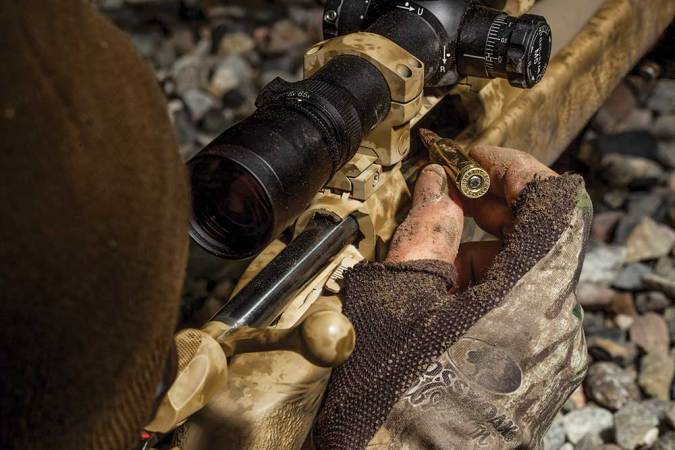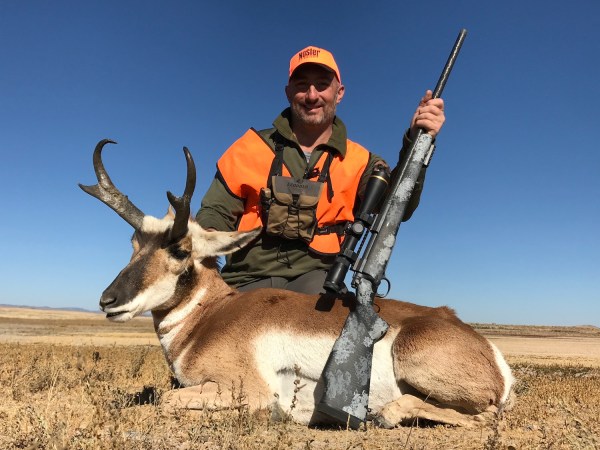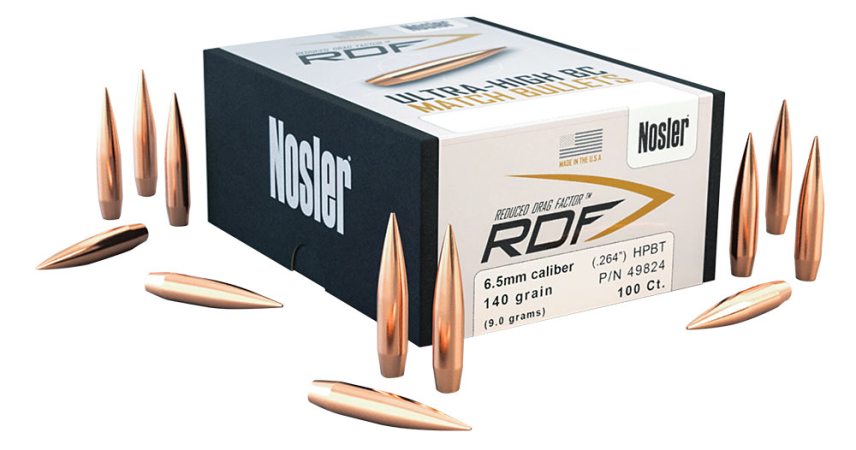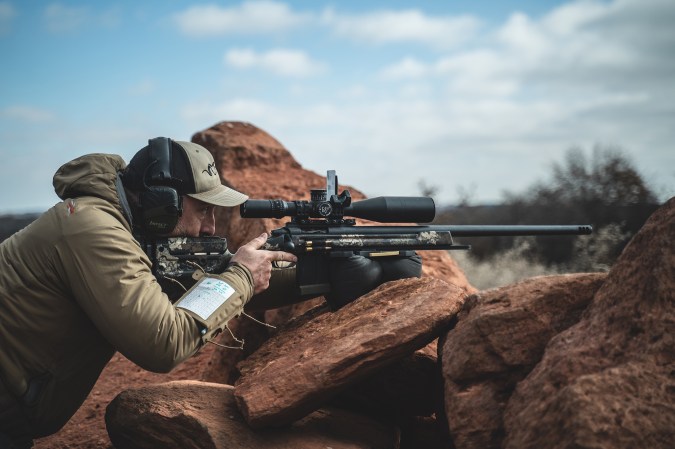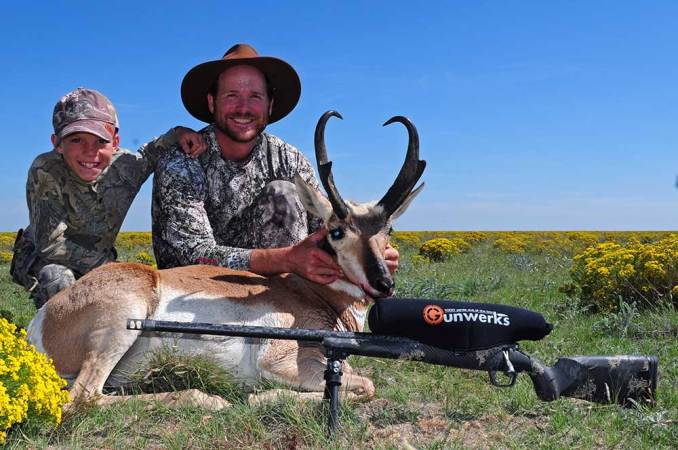We may earn revenue from the products available on this page and participate in affiliate programs. Learn More ›
It started as the mere spark of an idea back in 2007. I wanted to write an article about how one goes about developing a wildcat cartridge. As a fan of long-range shooting, and in order to give the story an editorial hook with some sex appeal, I decided a cartridge capable of accurate 1,000-yard shots that had moderate recoil was the way to go. My ambitions for this wildcat extended no further than getting a good feature out of it, and using it to hunt coyotes and deer.
The 6.5 Creedmoor had been introduced earlier that year and it seemed like a good candidate for a parent cartridge. I spoke with my friends at Hornady and they agreed to help out. Necking the 6.5 down for 6mm bullets was simple and straightforward, and the round seemed like it would meet my criteria.
Thus the 6mm Creedmoor was born. But here’s a bit of trivia you won’t read anywhere else: Its original name was the 6mm HOLE, for Hornady–Outdoor Life Express, a clever moniker I was fond of but that was soon rejected by my pals at Hornady as too cute. It pains me to admit it, but they were right.

The First 6 Creedmoor
A cartridge is only as good as the rifle that sends it downrange, so I needed to find someone to build a gun that would do it justice. I knew George Gardner, owner of GA Precision, by reputation, but I had never spoken with him before. Friends of mine who own GA rifles boasted about their ruggedness and accuracy. (GA stands for “Gnat’s Ass,” a reference to the tight groups his rifles make.) I called George up and explained the project. After quizzing me about the details, he agreed to pitch in.
I sent him a Sako 85 action and a McMillan stock. Hornady helped George procure a reamer and made custom reloading dies for the two of us. I got a barrel from Bartlein, and I ordered a Surefire muzzle brake and sound suppressor. Warne built a custom one-piece 20-MOA Picatinny rail for the dovetails on the Sako receiver, and I topped it with a Leupold M5 scope. Once George finished the rifle, I sent it to Jeremy Holmes, a talented artist who adorned it with Mongolian nomads on horseback using eagles to hunt wolves.
The 6 Creed’s performance was as dazzling as the rifle’s paint job. Using 105-grain A-Max bullets behind 43.2 grains of H4831SC, it had no difficulty ringing steel at 1,000 yards and beyond. Mission accomplished. We did this work in 2009, and the story appeared in the August 2010 issue of Outdoor Life, after which George and I didn’t give much thought to the little wildcat and moved on to other projects.
Little did we realize, however, we had planted a seed that was poised to blossom. It just needed the right environment in which to flourish. That came along a couple of years later, with the rise of Precision Rifle Series (PRS) competition.
The Perfect PRS Cartridge
In the PRS, shooters race against the clock to hit steel targets that are worth different point values, depending on their difficulty. Every shooter strives for first-round hits, which are typically worth more points, but the ability to spot misses and make quick corrections with follow-up shots is one skill that separates top competitors from the rest of the pack. Depending on the time allotted, it can be a sprint to engage all the targets in a stage, which can be anywhere from 10 to 1,300 yards downrange, so quick shooting is a must. A good PRS cartridge must shoot flat, not beat up the shooter with recoil, use bullets with high BCs that buck the wind, and not have a muzzle velocity in excess of 3,200 fps so as not to damage the targets. The 6 Creedmoor fit the bill perfectly.
“When the PRS started, semi-autos seemed like the way to go,” Gardner says. “You had high round-count stages and quick target transitions. I’d been shooting the .243 for years, but when you load target bullets to full length in the .243, they won’t fit in an AR-10 magazine.
“I was scratching my head and thought the 6 Creedmoor might work. I’d left the reamer in a toolbox and the dies were sitting on a shelf in my house, literally gathering dust,” he says. To test his theory, Gardner chambered an AR-10 barrel in 6 Creed, loaded some rounds, and in a few days was shooting. He liked how it ran and made a second AR-10 barrel for Jeff Bradley, who is on George’s official shooting team. A few weeks later, the two of them used their 6 Creeds in a local Missouri PRS match. Bradley took third place, and other shooters took notice.
The following season, in 2013, the other members of George’s team wanted to shoot 6 Creedmoors, but in bolt guns. George built the rifles and the shooters did very well, with five of them finishing in the top 10 in the PRS finale.
PRS shooters upgrade gear quickly if they feel it will give them an edge, and based on how well the 6 Creedmoor did, demand started to grow. Both Gardner and other custom rifle makers turned out 6 Creed rifles at a steady rate. I certainly wasn’t going to be left in the dust, so I had George build me a 6 Creedmoor for PRS competition too. From the start, ammo was an issue. Taking 6.5 Creedmoor brass and necking it down isn’t difficult, but it is time consuming, and the handful of boutique companies that made 6 Creedmoor loads couldn’t meet the demand.
“At the next SHOT Show, I talked with Hornady and they told me they would make 6 Creedmoor brass, properly sized and headstamped, but that the minimum run was 100,000 pieces,” Gardner says.
He took a leap of faith and placed the order. The brass sold out in about a month.

The 6MM Creedmoor Against Top Cartridges
This was the first real indication that the round was generating momentum beyond the community of 6 Creed PRS shooters, who numbered perhaps a few dozen. Nobody knew the exact number of 6 Creedmoor rifles that were being used in matches or slung over shoulders during deer season, but reports started to trickle in from hunters and long-range enthusiasts who had converted. Since that initial order, Gardner has sold more than 1 million pieces of 6 Creedmoor brass.
Of course, the 6 Creedmoor faced competition from other rounds. The 6XC cartridge that David Tubb initially developed for High Power had been around for a couple of years before the 6 Creed appeared, but it was costly to reload and doesn’t offer quite as much speed.
Other 6mm cartridges cropped up too. The 6×47 Lapua, 6mm Dasher, and 6mm Super LR have made their mark, and every now and then someone still steps up to the line with a .243 Win. These are all viable cartridges, but the 6 Creed is the king of the pack, used by more of the top 50 PRS shooters than any other.
What about the 6.5mm cartridges like the 6.5 Creedmoor, .260 Rem., and 6.5×47 Lapua that had also been highly touted? They still have their fans and still rack up wins, but the migration to 6mm cartridges is undeniable.
The excellent precisionrifleblog.com, run by Cal Zant, is a wealth of information about long-range shooting, and his data show that whereas the split among the top shooters using 6mm vs. 6.5mm cartridges was roughly equal in 2012 and 2013, with 6mms holding a slight edge, in 2014 the gap started to widen in favor of the 6mms. Now that Hornady is offering the 6 Creedmoor as a factory load with its new 108-grain ELD Match bullet this year, you can bet more shooters will take to the round and that it will gain a firmer hold with long-range marksmen.
Rifle makers have noticed as well. Montana Rifle Company, Savage, Ruger, and Browning all have factory 6mm Creedmoor guns in the works, most of which are geared toward hunters.
These developments—Hornady offering it as a standard load, and several major firearms companies building rifles—mean the 6mm Creedmoor’s long-term success is assured.
Why the 6mm Creedmoor is Better than the Rest
I frequently get asked what makes the 6mm Creedmoor better than other cartridges, especially those like the .243 Win., which seem so similar on paper. I usually say, “It wins.” That answer is a bit glib, but there’s truth to it as well. Dissecting the pros and cons of specific cartridges is difficult, but there are a couple of features about the 6mm Creedmoor, which happen to be shared by many of the other cartridges listed above as well, that shed some light on the matter.
The 30-degree slope of the shoulder is one advantage. This not only promotes better brass life than the shallower shoulders on the .243 Win. and .308 Win. for example, but we’ve come to learn that cartridges with this shape are very efficient, meaning we can achieve velocities equivalent to other cartridges that are able to hold more powder.
The long neck on the 6mm Creedmoor provides a lot of surface area to grip the bullets, providing good, consistent neck tension, aiding accuracy. And we’ve already touched on the fact that we can load long bullets in the case to full length, allowing them to cycle through magazine-fed standard-length actions without difficulty.
The velocities attained by the cartridge hit a sweet spot as well. Depending on the powder, bullet weight, and barrel length, the 6 Creedmoor has muzzle velocities from just below 3,000 fps up to 3,150 fps or so. At these speeds, you get excellent downrange performance while having good barrel life as well. And the longer a barrel remains “a shooter,” the more opportunity there is for the person behind the trigger to master the rifle and cartridge before rebarreling.
One also cannot ignore the financial side of the equation either. When the 6.5 Creedmoor was developed, one of its explicit goals was to be easy and economical to reload. Those characteristics were passed down to the 6 Creedmoor. The brass is reasonably priced, and the powder and other components are readily available.
Prior to the introduction of the new 6mm bullets (see p. 41), the go-to load for the 6 Creed was 42.2 grains of H4350 driving 105 gr. Berger Hybrids.
This is still a formidable load and will continue to be competitive despite the arrival of the newcomers nipping at its heels.
6MM Creedmoor Accuracy and Performance
This notion of the modern, moderate cartridge is only going to become more popular as time goes on. Rounds like the 6.5 Creedmoor, the .260 Remington, the .338 Federal, and, of course, the 6 Creed are all good examples of this design philosophy. There are still plenty of shooters obsessed with speed—just take a look at the 6.5-300 Weatherby and the 26 Nosler—but with today’s modern hunting bullets, we are able to take larger game more easily and ethically than ever with the aforementioned softer-shooting rounds.
If you put two shooters behind similar hunting rifles, one chambered in .300 Win. Mag. and the other in 6mm Creedmoor, I can guarantee you that the person using the 6 Creed will shoot more often, be more accurate, and, ultimately, be more deadly than the guy trying to master the .300 Win. Mag.—at any range.
I’ve been competing with the 6 Creedmoor for years, but I only started hunting big game with it more seriously two seasons back. During the fall of 2015, between my son and my friends and me, we tagged eight animals with my two GA Precisions, including four antelope, three whitetails, and a mule deer.
Our shots ranged from 20 feet—a whitetail buck that walked within arm’s reach of my son—to 468 yards—his first mule deer. The rest of the animals were taken between 380 and 450 yards. All were rock-solid one-shot kills.
Credit has to go to the pinpoint accuracy Gardner’s rifles achieve in the 6 Creedmoor. Bullet placement is the most important factor when it comes to making a clean kill, and having a rifle and cartridge that are able to place shot after shot into the mouth of a coffee can at 500 yards makes the task much easier.
I’m not alone in my enthusiasm for the 6 Creedmoor on game. Many predator hunters, including one federal trapper whose main job is predator control, consider the 6 Creedmoor the ultimate coyote round.
All this success is just a taste of what’s to come for the 6 Creedmoor. This year a lot more hunters and shooters are going to have a chance to experience what all the fuss is about. Based on how the 6 Creed has excelled in competition and in the field to date, I’m guessing they are going to be happy with what they see.
Not bad for a cartridge that was just meant to be a one-off for a story in a magazine.




